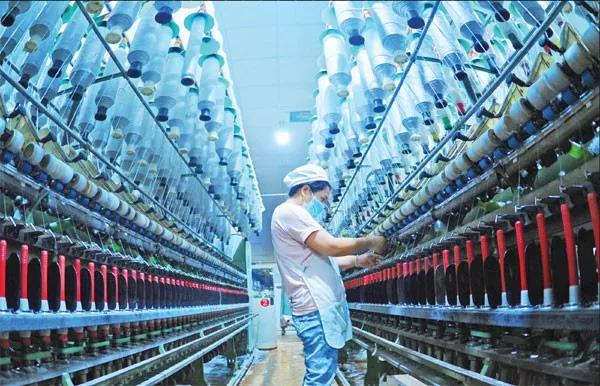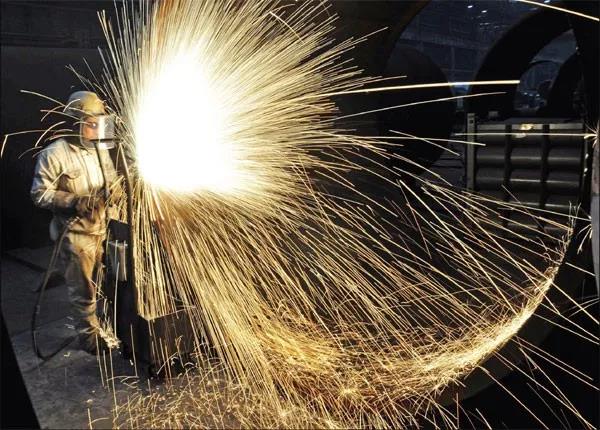
China Daily Europe, May 4, 2018
Economy continues to expand amid restructuring toward services, consumption and high-quality manufacturing
China’s GDP continued to grow at an unexpectedly fast rate of 6.8 percent from January to March, while the economy continued restructuring toward services, consumption, entrepreneurial companies and higher-quality manufacturing. Retail sales grew by 9.8 percent and the service sector grew by 7.5 percent from the same period of last year – both higher than the growth rate of overall GDP.
Final consumption expenditure in all of 2017 accounted for 58.8 percent of economic growth, while capital formation accounted for only 32.1 percent. Net exports contributed 9 percent of growth, according to the National Bureau of Statistics.
Although export growth remained strong in the first quarter, imports, mostly of consumer goods, grew even faster. So China’s trade surplus was about one-fifth lower than in the same period last year, according to NBS data. As a result, net exports dragged down GDP growth by about 0.5 percentage point from January to March, in contrast with the boost of 0.6 percentage point from net exports in 2017.

Geng Yuhe / Xinhua
Although export growth remained strong in the first quarter, imports, mostly of consumer goods, grew even faster. So China’s trade surplus was about one-fifth lower than in the same period last year, according to NBS data. As a result, net exports dragged down GDP growth by about 0.5 percentage point from January to March, in contrast with the boost of 0.6 percentage point from net exports in 2017.
“When you look at real economic growth, most people, including ourselves, expected headline GDP growth to come in a little bit lower than it did in the first quarter of 2018,” says Jurgen Conrad, head of the economics unit at the Asian Development Bank’s resident mission in China. He adds that “6.8 percent, the same as in the fourth quarter of last year, was surprise No 1. Surprise No 2 was that consumption growth and service sector growth remained strong but were a little bit less than last year. Out of the 6.8 points of total growth, 5.3 points in January through March came from consumption, but in the first quarter of last year it was 5.5 percentage points.
“So it is fair to say that consumption is the main driver of growth on the demand side,” Conrad says. “On the supply side, services are clearly the main driver. This is very much in line with the goal of rebalancing – very much a success of the government.”
A rise in the service sector’s use of electrical power confirms this shift. According to Li Fulong, head of the Development Planning Department of the National Energy Administration, robust service sector growth drove a 9.8 percent increase in power use from January to March. “Supply-side structural reform and new growth momentum have all contributed to the growth in power consumption, and there has also been a trend of slower power use in traditional energy-consuming sectors. Service sector electricity consumption rose by 16.7 percent, followed by a 10.3 percent increase in the agricultural sector and 6.7 percent for the industrial sector,” Li told China Daily earlier.
Median per capita disposable income grew by 8.5 percent in the first quarter, exceeding the 7.1 percent rate seen in 2017, supporting the shift to consumption. Per capita expenditures of rural households grew by 8.8 percent, exceeding the urban rate of 3.4 percent and showing some progress toward narrowing the urban-rural gap, according to NBS data.
Hu Yuexiao, chief economist of Shanghai Securities, has forecast that, during the remainder of 2018, the basic trend in the Chinese economy will be stable and improving growth. “Although its GDP growth rate has not picked up significantly, the quality of growth has been improved. As investment stabilizes and corporate profit levels rise, the market will become more confident in the country’s economy,” he told China Daily earlier.
Experts describe monetary and fiscal policy going forward as prudent – aiming to continue high-quality growth without stimulating either a bubble or a disruptive slowdown.
Qu Qiang, research fellow at the International Monetary Institute of Renmin University of China, says: “Monetary policy is stable, neutral now. Which means that we have to watch all the indicators in the market. We cannot let the interbank or other indicators be too tight. We don’t want to see SHIBOR (the Shanghai Interbank Offered Rate) soar up quickly. If the interest rate goes up, the central government will step in to do window guidance. But we cannot let the economy be too loose; the banking sector and other financial sectors and borrowers can’t lever up.”
However, experts say weakening fixed asset investment and industrial production in March might lead to somewhat more stimulative fiscal and monetary policies for the remainder of 2018.
“The government may stimulate economic growth through a proactive fiscal policy in the coming months, especially through strengthening fiscal policy in the coming months and through strengthening expenditure with tax cuts, as the economic growth pressure has increased since March,” Gao Gu, general manager of the fixed-income department of Changan Securities, said in an earlier interview with China Daily.
On April 17, the People’s Bank of China reduced its reserve requirement by 1 percentage point. But the bank said the move was intended to deal with short-term liquidity issues and will not change the regulator’s determination to achieve the longterm goal of financial deleveraging in a tightening regulatory environment.
Conrad, of the ADB, says: “The government on both the fiscal side and the monetary side has bought itself more flexibility, which it feels it needs this year, with the international environment being a little bit less predictable. On the one hand, the government is interested in reducing some of the risks – local government debt, financial sector leverage, nonbank financial institutions. That all leads to tightening monetary and fiscal policies. Indeed, since headline growth is still strong, they should tighten a little bit. On infrastructure, it is a good moment to tighten. On the other hand, no one knows what to expect in the second quarter, so you need to be flexible. The policy approach allows the government to be flexible and supportive where necessary and tighten and be less supportive where that is merited.”
Emphasis on labor market
In the first quarter, 3.3 million urban jobs were created, including 1.54 million in March alone, according to data released in April by the National Development and Reform Commission, the country’s top economic regulator. This is in line with the target, laid out by Premier Li Keqiang during the first session of the 13th National People’s Congress in March, to create 11 million new urban jobs in 2018.
In March, the national surveyed unemployment rate was 5.1 percent, according to the NBS. This was below the goal of 5.5 percent set in the Government Work Report during the NPC session. Ning Jizhe, head of the NBS, previously told China Daily that adding this new gauge reflects that the central government has put strong emphasis on the labor market as the nation steers toward high-quality growth.

Yu Fangping / Xinhua
Over the five years from 2013 to 2017, China created more than 13 million new urban jobs each year, amounting to 66 million new jobs over the period, despite the negative effect of economic restructuring and slowing growth, according Yin Weimin, minister of Human Resources and Social Security. Ninety percent of college graduates found jobs, and more than 1.1 million redundant workers from the country’s excess production capacity cuts were re-employed, he said.
Qu, the research fellow at the International Monetary Institute, says entrepreneurs are an important labor force absorber. “In the 1990s, when China first began to reform its State-owned enterprise sector, hundreds of thousands of SOE workers were laid off, and that was a disaster, since China was not prepared to welcome that kind of shock because we did not have a mature and market-oriented social security system.
“But right now, I don’t think the government is afraid of that situation recurring again, because in Beijing alone we have 200,000 Didi and Uber drivers. We have at least 100,000 delivery guys in Beijing alone. And there are so many in secondary or tertiary cities. So this demand is actually gulping up all of this labor force,” he says.
According to the Ministry of Industry and Information Technology, the added value of the high-tech manufacturing segment surged by 11.9 percent year-on-year in the first quarter. Fixed asset investment in the sector rose by 7.9 percent from the same period last year. Both grew faster than the overall industrial sector.
The China Internet Plus Index, issued by the Tencent Research Institute in April, showed that China’s internet-based digital economy rose by 17 percent in 2017 and now amounts to 32 percent of the overall economy.
Edward Tse, founder and CEO of Gaofeng Advisory Co, says the continuing rapid growth of employment was made possible by a shift toward entrepreneurship and the private sector. “A study done by the Chinese Academy of Social Sciences found that the new economy has been generating twice the GDP growth as the average. The private sector is generating an incredible amount of new employment.”
He notes that many university graduates join companies like Alibaba or Tencent. They get immersed in the environment, learn something, then sometimes leave to found a new startup. A small number of them might become unicorns (startups valued at more than $1 billion), serving in turn as role models for others. “This is where the strength and resilience of the Chinese economy is and why it will continue to do well. It provides sufficient upward mobility for young people in a legitimate way,” he says.
“China is changing at a very fast rate. There are a lot of new opportunities and new ideas that come out to do innovation, which is sometimes technology-driven, but it is sometimes business-model-driven. There is a lot of innovation,” he says.
Tse also points out that, unlike in the United States, entrepreneurial opportunities are found throughout the country. “The mass innovation and entrepreneurship advocated by Premier Li Keqiang is spreading all over China. That is a major source of resilient growth. Beijing, Shenzhen and Hangzhou are really famous for innovation, but you get innovators all over, including in some of the smaller towns. Plus, they are spreading across a range of different sectors, not just one or two,” he says.
Another goal of restructuring is to reduce excess capacity in the steel, coal, glass and cement industries. According to Ministry of Industry and Information Technology spokesman Huang Libin, “In the first quarter, the comprehensive utilization rate of the steel segment recovered to about 80 percent, a reasonable range.” Overall industrial capacity utilization rose to 76.5 percent, up by 0.7 percentage point year-on-year.

Yang Wenbin / Xinhua
Chi Fulin, head of the China Institute for Reform and Development, said earlier that “the shifts show the Chinese economy is becoming dominated by the service sector. Under downward pressures, industrial upgrades are vital for sustaining economic growth and avoiding the middle-income trap.”.
Central State-owned enterprises saw profits rise by 20.9 percent year-on-year in the first quarter, up from 15.2 percent in 2017, according to data from the State-owned Assets Supervision and Administration Commission. Their average asset liability ratio stood at 65.9 percent by the end of March, down by 0.4 percentage point from the start of the year.
Peng Huagang, deputy secretary of the commission, says central SOEs have earnestly implemented the requirements for deleveraging by controlling the scale of interest-bearing liabilities and supplementing equity capital. Experts also attribute part of the profit rise to a significant increase in commodity prices, which were partly driven by the reduction of excess capacity in those industries.
Going forward
In recent speeches, President Xi Jinping stressed the need for further opening-up measures to fight “three tough battles” – prevention of major risks, targeting poverty alleviation and controlling pollution. Recent data shows that the economic restructuring is supporting all three of these goals.
“China will push reform and opening-up more actively, and deepen State-owned enterprise and asset as well as fiscal and financial reforms, to implement major opening-up measures previously fixed,” said a statement released after a meeting last month of the Political Bureau of the Communist Party of China Central Committee.
Recent data from the NBS shows that part of the consumption growth was made possible by an expanded social safety net that alleviates poverty. Li Xunlei, chief economist at Zhongtai Securities Co Ltd, said earlier that, in order to unleash its consumption potential, China needs to further improve its social security network and social welfare including public education, elderly care and healthcare.
According to a recent paper by Cai Fang and Zhang Ziaojing of the Chinese Academy of Social Sciences, “The Chinese economy has entered a ‘new normal’ characterized by slower growth, faster structural change and the transformation of growth drivers. In this new era, the dividends from reforms that increase productivity rather than the accumulation of production factors are the only way for China to achieve sustainable economic development and avoid the middle-income trap.”
Experts agree on the need for continued reforms. For example, John Litwack, lead economist at the World Bank office in Beijing, says: “Restructuring is taking place. You could argue about whether it is fast enough, but things are happening, certainly. Rebalancing is proceeding. The measures the government took to bring credit growth under control and reduce some of the commercial bank exposures to shadow banking – those were all very serious measures and they had a measurable impact. In terms of excess capacity, there are complicated social issues involved, but they are moving.”
He says the big issues going forward are “pushing market discipline with a framework for bankruptcy that gets creditors active in enterprise restructuring”.
“We think that there is huge potential in just reallocating investment capital toward more productive areas. Productivity is still one-third of what it is in the US, so there is still a lot of growth potential. The Chinese economy is extremely dynamic. If they do these things, nothing can stop China.”

